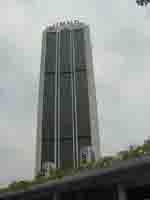|
|
|
|||||||||||||||||||
|
Orbit calculations
Micro Satellite: Model Angkasa
Introduction Developed and Designed by Crystal Communication Sdn Bhd. The satellite weighs ~50 kg and orbit geostationary between 300 km to 800 km above the earth. It has got 2 optical system and can zoom the earth by normal optics and infra red. The mirror type telescope zoom the earth with best zoom at 100 m by 100 m square. The wide angle lens face upwards towards the horizon with fish eye lens at 8mm.
Technology Propulsion: Uses a high power laser that accelerates the rocket more than 40,000 km/hr to escape the earth gravity. Body structure: Titanium, Light but harder than steel. Battery: Rechargeable lithium ion. Solar: Generate more than enough power to control the whole rocket system. Also with this power able to heat up certain critical circuit to function normally. Thermal insulation: Able to meet direct sunlight at 120 deg C and a low temperature of -160 deg C.
Design Shape: Ergonomic in design with lightweight titanium body. The body is covered with ceramic to withstand a temperature of 1500 deg C of heat when it escapes the earth’s gravity.
Radio Frequency (note: only light and shorter radio waves are used) We transmit in the C and K band frequencies for audio video of more than 60 channels and radio telecommunications of more than 100 channels. On earth, AM from 530 kHz to 1610 kHz, 100 channels tunable. FM from 87.50 MHz to 108.00 MHz, 100 channels tunable. TV channels, 20 tunable.
Important information Average radius of earth 6.37 x 106 m Average earth-moon distance 3.84 x 108 m Free fall acceleration 9.80 m/s2 Mass of earth 5.98 x 1024 kg Mass of moon 7.36 x 1022 kg
Let us understand our atmosphere layers that cover the world.
We have to position our satellite geostationary at our required location.
With that, we have to understand the effect of (i) earth rotation around the sun and (ii) the moon rotating around our earth. This is explained by the lunar eclipse movie.
(Please use a media player to view this)
Some simple calculations (1) Satellite in orbit Satellites can be launched from the earth’s surface to circle the earth. They are kept in their orbit by the gravitational attraction of the earth.
Orbit 1
Earth
Fig. 1
Consider a satellite of mass m which just circles the earth of mass M close to its surface in an orbit 1 as in Fig. 1. Then, if r is the radius of the earth,
mv2 Mm ----- = G ----- = mg r r2
where g is the acceleration due to gravity at the earth’s surface and v is the velocity of m in its orbit. Thus,
v2 = rg
and hence, using r = 6.4 x 106 m and g = 9.8 m s-2 ,
v = sqrt (rg) = sqrt (6.4 x 106 x 9.8)
= 8 x 103 m s-1
= 8 km s-1
The velocity v in the orbit is thus about 8 km s-1. In practice, the satellite is carried by a rocket to the height of the orbit and then given an impulse, by firing jets, to deflect it in a direction parallel to the tangent of the orbit. Its velocity is boosted to 8 km s-1 so that it stays in the orbit. The period in orbit,
circumference of earth = ---------------------------- v
2p x 6.4 x 106 m = -------------------- 8 x 103 m s-1
= 5000 sec.
= 83 min
(2) Parking orbits Consider now a satellite of mass m circling the earth in the plane of the equator in an orbit 2 concentric with the earth. Fig.2.
Orbit 2
Earth
Fig. 2
Suppose the direction of rotation as the same as the earth and the orbit is at a distance R from the centre of the earth. Then if v is the velocity in orbit,
mv2 GMm ----- = -------- R R2
But GM = gr2, where r is the radius of the earth.
mv2 mgr2 ----- = -------- R R2 gr2 v2 = ---- R2 If T is the period of the satellite in it’s orbit, then v = 2pR/T
4p2 R2 gr2 -------- = ---- T2 R
4p2 R3 T2 = -------- ----- (i) gr2
If the period of the satellite in its orbit is exactly equal to the period of the earth as it turns about its axis, which is 24 hours, the satellite will stay over the same place on the earth while the earth rotates. This is sometimes called a parking orbit. Relay satellites can be placed in parking orbits, so that for example a television programmes can be transmitted continuously from one part of the world to another.
Since T = 24 hours, the radius R can be found from (i). Thus from
(T2 gr2) R = 3 sqrt --------- (4p2)
and g = 9.8 m s-2 , r = 6.4 x 106 m,
(24 x 3600)2 x 9.8 x (6.4 x 106)2 R = 3 sqrt --------------------------------------- (4p2)
= 42400 km
The height above the earth’s surface of the parking orbit = R – r = 42400 – 6400 = 36000 km
In the orbit, the velocity of the satellite 2pR = ------ T
2p x 42400 = --------------- 24 x 3600 s
= 3.1 km s-1
(3) Satellite fixed orbit of 500 km above the surface of earth A satellite is to be put into orbit 500 km above the earth’s surface. If its vertical velocity after launching is 2000 m s-1 at this height, calculate the magnitude and direction of the impulse required to put the satellite directly into orbit, if its mass is 50 kg. Assume g = 10 m s-2; radius of earth, R = 6400 km. Suppose u is the velocity required for orbit, radius r. Then,
mu² GmM gR² ---- = ------- = ----- r r² r²
GM as ------ = g R²
Therefore, gR² u² = ----- r
Now R = 6400 km, r = 6900 km, g = 10 m s-²
Therefore, 10 x (6400 x 103)² u² = ------------------ 6900 x 103
u = 7700 m s-1
At this height, vertical momentum Uy = mv = 50 x 2000 = 100000 kg m s-1
Uy Ux
Uy U
Fig. 3
Horizontal momentum required,
Ux = mu = 50 x 7700 = 385000 kg m s-1
Therefore impulse needed, U = sqrt (Uy² + Ux²)
= sqrt (100000² + 385000²)
= 4.0 x 10² kg m s-1
Direction The angle q made by the total impulse with the horizontal or orbit tangent is given by, tan q = Uy / Ux
100000 = --------- 385000
= 0.260
Thus, q = 14.6°
(4) Bonus question Velocity of escape Suppose a rocket of mass m is fired from the earth’s surface Q so that it just escapes from the gravitational influence of the earth. Then work done = x potential difference between infinity and Q
GM = m x ------- r GM therefore kinetic energy of rocket = ½ mv² = m x ------- r
(2GM) v = sqrt --------- = velocity of escape r
Now GM/r² = g
v = sqrt (2gr)
v = sqrt (2 x 9.8 x 6.4 x 106
= 11 x 103 m s-1
= 11 km s-1
With an initial velocity of about 11 km s-1, a rocket will completely escape from the gravitational attraction of the earth. It can be made to travel towards the moon, so that it eventually comes under gravitational attraction of this planet.
Earth circle (v=11 km s-1) ellipse (v<ve) parabola (v=ve) hyperbola (v>ve)
Fig. 4
Summary With a velocity of 8 km s-1 a satellite can describe a circular orbit close to the earth’s surface. With a velocity of 8 km s-1 but less then 11 km s-1 a satellite describes an elliptical orbit round the earth.
The satellite communication network
Orbits of other geostationary satellites
Others stayed at 40,000 km
30 channels transponder
Satellite transponder
Spot and multi beam coverage
|
1 |
||||||||||||||||||






